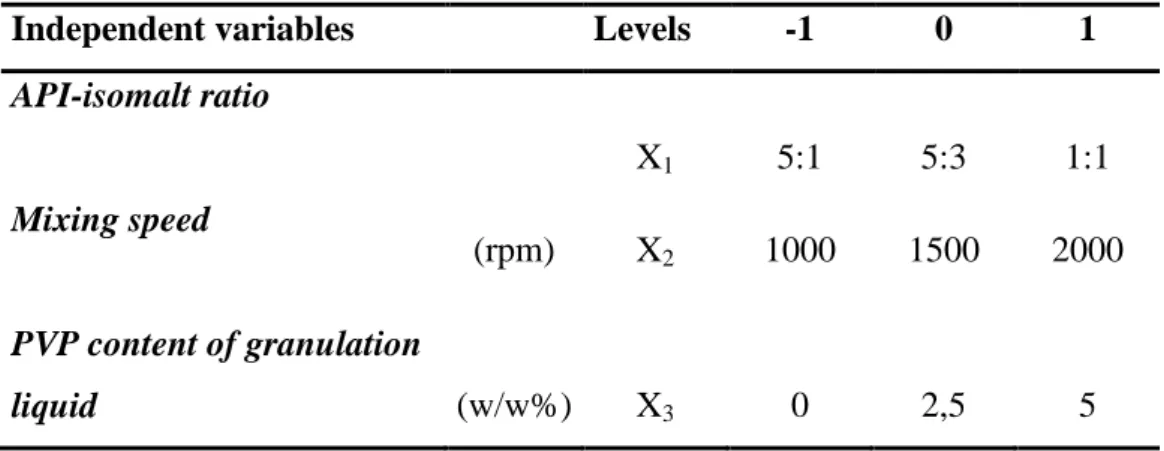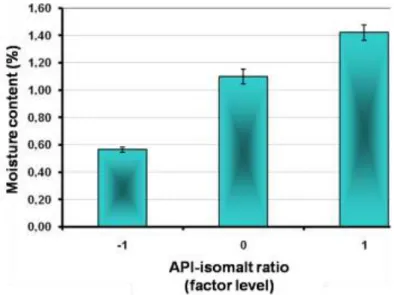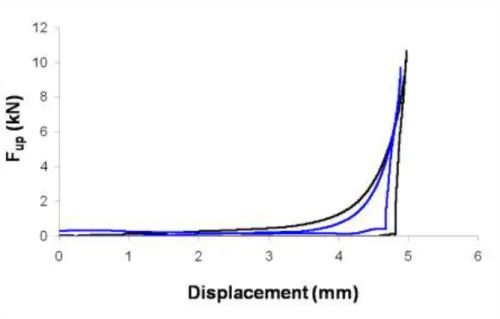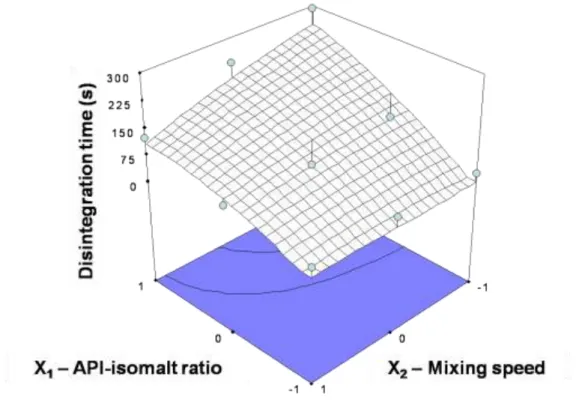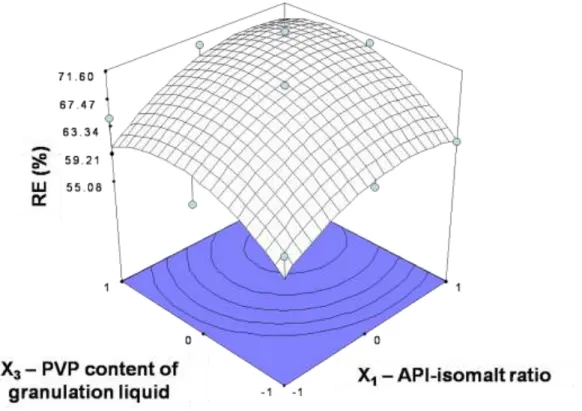Application of isomalt for the formulation of granules and tablets
Doctoral theses
Dr. Zsófia Éva Sáska
Semmelweis University
Doctoral School of Pharmaceutical Sciences
Supervisor: Dr. István Antal, Ph.D.
Official reviewers: Dr. Ildikó Bácskay, Ph.D.
Dr. Judit Balogh, Ph.D.
President of the Final Exam Committee: Dr. Kornélia Tekes, Ph.D.
Members of the Final Exam Committee: Dr. Gabriella Újhelyi, Ph.D.
Dr. Miklós Vecsernyés, Ph.D.
Budapest 2012
2
Introduction
The aim of the formulation of a dosage form (e.g. tablet) is to deliver the active ingredient into the part of the human organization, where the active ingredient is able to exert its physiologic and/or therapeutic effect. Additionally, the dosage form intends to make its application convenient for the patient and facilitate the production in industrial scale.
Since most active ingredients represent reduced flowability and poor compactibility, in order to obtain a solid dosage form which meets the requirements of international regulations, excipients and appropriate preparative technological procedures are needed. Paracetamol is an important representative of this group, as its compactibility does not meet the requirements of a suitable compression. Moreover, its single dose is high (250 – 1000 mg). Therefore, in order to have a convenient per oral medical treatment, this active ingredient should be formulated with as less excipients as possible.
Isomalt is a sugar alcohol with a wide range of pharmaceutical applications as a result of its physicochemical properties. It is derived from sucrose in a two-stage production process. The monograph of isomalt can be found in the current pharmacopoeias. Although, it is widely used in food industry, its spreading in pharmaceutical industry has begun recently.
The purpose of my study was to evaluate the applicability of this novel excipient in pharmaceutical technology. In my work the granulation of paracetamol with isomalt and the compressibility of the produced granules were investigated. Moreover, the characteristics of the produced granules and tablets were examined with 33 type face centered full factorial design.
3
Aims of research
The objects of my research were as follows:
to use of milled isomalt for wet granulation process,
to enhance the compactibility of the model drug – paracetamol – with isomalt and to study the role of isomalt during the compression process,
to investigate the characteristics and the compactibility of the prepared granules (parameters of tabletting process and tablet properties),
to study factors with statistical evaluation which have influence on the formulation and on the properties of the dosage form (granule, tablet),
to examine the effect of independent variables – active ingredient- excipient ratio, mixing speed at granulation process, the quality of granulation liquid – on the characteristics of the formulated granules and tablets,
to chose initial compositions of a possible scale up to pilot production of paracetamol containing non-coated tablets according to the results of the factorial design.
4
Methods
Formulation of paracetamol containing granules and tablets
The granules were made with a Stephan UMC-5 Electronic Laboratory Mixer.
The granulation liquid was sprayed onto the mixture of the API and EXC through a 0.8 mm spray nozzle with 200 kPa pressure. The granules were dried for 24 h in a drying chamber (40 °C) then sized with an ERWEKA oscillating granulator through a 630 μm sieve. The granules were compressed into tablets with a single punch tablet machine (Type TM 20, Diaf) with flat, sharp-edged punches of 10 mm diameter. The external phase of the tablets contained 5%
crospovidone as disintegrant and 1% magnesium stearate as lubricant.
Characterization methods of granules, tabletting process and tablets
The granule flowability and angle of repose were measured with dry funnel, the bulk and tapped densities were determined with Stav 2003 type Stampfvolumeter and Omron HFCX-A4 counter. The particle size distribution of the prepared granules was measured using conventional sieve analysis on a Retsch AS 200 apparatus. The moisture content of the granules was determined with Scaltec SMO-01 electronic digital moisture analyzer. In order to follow the tablet compaction process instrumented punches involving KMT-LIAS-06- 3/350-5E type strain gauges were used. The displacement was measured by a Limes L2 type magnetic sensor. All signals were transferred through cables to the USB-6210 type data recorder, involving signal conditioning. The data acquisition was performed using NI-DAQmx 8.3. software. Data were analyzed by MS Excel macroprogram developed in-house. Tablet weight was measured using a Sartorius basic BA 1005 type analytical balance. The tablet thickness and diameter were measured with an Erweka TBH 200 type tablet testing apparatus equipped with a digital micrometer (Digimatic Indicator ID- C1012CB) using a spherical probe. The friability of the tablets was determined
5
with Erweka TAP friability tester; the disintegration time was measured with Erweka ZT 4 disintegration tester. The surface of divided tablets was investigated using scanning electron microscope (JEOL JSM-5600LV).
Experimental design
Paracetamol-isomalt (API-isomalt) granules were prepared based on the 33 type face centered full factorial design. As independent variables API-isomalt ratio (X1), mixing speed during granulation (X2) and PVP content of granulation liquid (X3) were chosen (Table 1.). The statistical evaluation of the results was performed with Design Expert 7.1 software. The quadratic model was used to analyze the responses. Response variables can be given with the following polynomial equation:
3 2 1 123 3 2 23 3 1 13 2 1 12 2 3 33 2 2 22 2 1 11 3 3 2 2 1
1X bX bX b X b X b X b XX b XX b X X b XXX
b a
Y (1)
where Y is the dependent variable and a is the arithmetic mean response of the 27 combinations. b1, b2 and b3 represent the individual effect, b11, b22 and b33
symbolize the linearity of the independent variables. b12, b13 and b23 are the coefficients of interactions between two independent variables, while b123
describes the interaction between the three independent variables.
Table 1. Factorial design parameters and experimental conditions
Independent variables Levels -1 0 1
API-isomalt ratio
X1 5:1 5:3 1:1
Mixing speed
(rpm) X2 1000 1500 2000
PVP content of granulation
liquid (w/w%) X3 0 2,5 5
6
Results and conclusions
1. Granule properties
As the results of granule characterization measurements indicate all formulated granules – agglomerated without or with PVP – meet the requirements of the current pharmacopoeias. The agglomeration process with milled isomalt did not need any other binders to obtain granules with proper quality. Furthermore, it can be stated that with the increase of isomalt content the moisture content of the granules raises as well (Fig. 1.). Thus isomalt enhances the compactibility of the granules, since it provides the appropriate moisture content to form interparticle bounds. Mixing speed is also a considerable parameter at granulation process, as faster mixing enhances granule particle size homogeneity. However it decreases the mean particle size of the granules. Therefore mixing speed influences the compactibility of the granules and the physical properties of the produced tablets also.
Fig 1. Moisture content of granules as a function of isomalt content. At the different isomalt levels the mean moisture content values of the 9 related batches are illustrated.
7
2. Evaluation of tabletting process
Isomalt enhanced the compactibility of the paracetamol containing granules, it decreased the friction between the particles, increased the lubrication of the system. PVP also enhanced the compression profile of the formulated tablets. The increase of its amount in the extent defined by factorial design enhanced the lubrication more than the amount of isomalt in the extent defined by factorial design. However the elasticity of the tablets rose as well. Fig. 2.
demonstrates the comparison of compression force-displacement function of a batch with lower and higher relative elasticity. The tabletting of granules agglomerated with water needed more work to overcome the friction and to compress tablets as the tabletting of granules agglomerated with PVP. The values of netto work seemed to be higher than the friction work at all 27 batches, although the difference is lower between friction and netto work in the case of granules with low isomalt content.
Fig 2. Compression force of as a function of displacement. The blue curve represents a more elastic batch (RE=71,14%), while the black curve represents a less elastic system (RE=55,70%).
8
3. Study of tablet properties
Isomalt and PVP improved tablet hardness and friability owing to their binder properties. Isomalt increased the moisture content of granules. The proper moisture content in a tablet is essential in forming enough interparticle connection during compaction. Tablets containing no PVP showed lower hardness and faster disintegration. Moreover, at lower isomalt content the phenomenon of capping could be observed. Furthermore, the increase of mixing speed reduced granule size, although it enhanced the homogeneity of granule particle size. Thus the optimal mixing speed at granulation is crucial, which ensures not only sufficient homogeneity but also appropriate granule size to enhance tablet quality.
4. Statistical evaluation of results
The results indicated that mixing speed had significant effect only on the particle size distribution of granules and on the disintegration time of tablets. Its interaction with API-isomalt ratio performed at the disintegration time of tablets compressed with 15 kN. Through its effect on granule particle size distribution it had also an impact on the tablet characteristics (Fig. 3.). Granule and tablet properties as well as parameters of tabletting process were influenced mostly by API-isomalt ratio and PVP content of granulation liquid (Fig. 4. and Fig. 5.).
The interactions occurred typically between these variables. Interaction between the three independent variables did not prove to be considerable.
9
Fig 3. Response surface plot for disintegration time of tablets compressed with 15 kN. The granulation was performed without binder.
Fig. 4. Response surface plot for the tapped density of granules at 2000 rpm mixing speed.
10
Fig. 5. Response surface plot for relative elasticity at 2000 rpm mixing speed and 10 kN compression force.
11
List of publications
Publications connected to the thesis
1. Sáska Zs, Dredán J, Balogh E, Luhn O, Shafir G, Antal I. (2010) Effect of isomalt as novel binding agent on compressibility of poorly compactable paracetamol evaluated by factorial design. Powder Technol. 201: 123-129. 10.1016/j.powtec.2010.03.009
(IF: 1.887)
2. Sáska Zs, Dredán J, Balogh E, Luhn O, Shafir G, Antal I. (2011) Evaluation of the impact of mixing speed on the compressibility and compactibility of paracetamol – isomalt containing granules with factorial design. Powder Technol. 213: 132-140.
10.1016/j.powtec.2011.07.019 (IF: 1.887)
Publications not connected to the thesis
1. Sáska Zs, Hajdú M, Laki M, Klebovich I, Antal I. (2008) Szemészeti hatóanyag- felszabadító rendszerek fejlesztési lehetőségei. Acta Pharm Hung. 78: 156-164.
2. Laki M, Hajdú M, Zahár A, Sáska Zs, Klebovich I, Szendrői M, Antal I. (2007) Csontműtéteknél alkalmazható antbiotikum-tartalmú hordozórendszerek tervezése.
Acta Pharm Hung. 77: 108-115.
